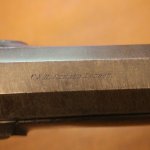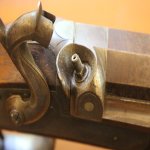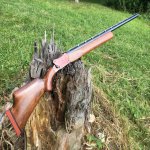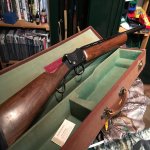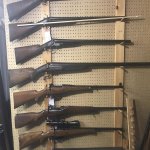You are using an out of date browser. It may not display this or other websites correctly.
You should upgrade or use an alternative browser.
You should upgrade or use an alternative browser.
Lets see them single shots
- Thread starter brybenn
- Start date
This one is signed GEORGE WOOD LONDON on the barrel, GEORGE WOOD on the lock. But post 1813 Birmingham proofs on the barrel, as well as ROSE. The barrel forger? Note the inset breech, making the gun very slender. Condition is so-so. I bought it thinking it would be a shooter, but the 12ga bore was badly pitted. I reamed it up to .750, and there were still pits, so I sleeved it. Made it heavier than it was originally, but that isn't necessarily a bad thing, as far as recoil is concerned.
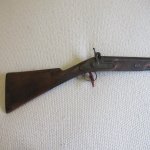
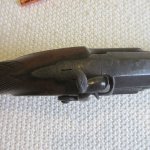
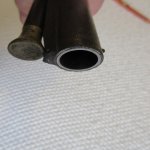



Attachments
This one is a Cogswell & Harrison.
Very nice!
OK, here are two ‘Best’ singles that are considerable rarities.
The first is a 12-bore double-bite screw grip rotary-underlever pinfire sporting gun by Boss & Co. of London, ordered by Sir John Harpur-Crewe (1824–1886), 9th Baronet of Calke Abbey and High Sheriff of Derbyshire, on 1 July 1864 and completed on 5 October the same year. I believe the gun was purchased for his son Vauncey’s 18th birthday. Sir Vauncey Harpur-Crewe (1846-1924) became the 10th (and last) baronet. He was a very avid shooter and collector of natural history specimens (a hobby for which this is the perfect gun). The gun has a short sighting rib at the breech signed “Boss & Co. 73 St James Street London”, and the back-action lock is signed “Boss & Co.”. It has a 30 1/16” damascus barrel, which still has a mirror bore. The gun weighs a very light 5 lb 4 oz. As with all Boss guns the engraving was by John Sumner, and I suspect it was actioned by E. C. Hodges. If I’m not mistaken, Boss & Co. only made three pinfire singles in all.
If you Google 'Calke Abbey' and 'taxidermy', you will see many specimens which I expect were collected with this gun.



The second is a 12-bore double-bite screw grip rotary-underlever pinfire sporting gun by John Dickson & Son of Edinburgh, made in 1875. It also has a short sighting rib over the breech, and the barrel is signed “John Dickson & Son, 63 Princes Street, Edinburgh”, and the back-action lock simply “John Dickson & Son”. The fine damascus barrel is 31 1/16” in length and still has a mirror bore. Both the barrel and action carry the maker’s mark J.D.&S, leaving no mystery as to who built the gun. Unfortunately the sales ledger no longer exists so it is not possible to trace the original owner, but it is one of only 10 single pinfires made by Dickson between 1864 and 1875. This gun is heavier, at 6 lb 7 oz.

The first is a 12-bore double-bite screw grip rotary-underlever pinfire sporting gun by Boss & Co. of London, ordered by Sir John Harpur-Crewe (1824–1886), 9th Baronet of Calke Abbey and High Sheriff of Derbyshire, on 1 July 1864 and completed on 5 October the same year. I believe the gun was purchased for his son Vauncey’s 18th birthday. Sir Vauncey Harpur-Crewe (1846-1924) became the 10th (and last) baronet. He was a very avid shooter and collector of natural history specimens (a hobby for which this is the perfect gun). The gun has a short sighting rib at the breech signed “Boss & Co. 73 St James Street London”, and the back-action lock is signed “Boss & Co.”. It has a 30 1/16” damascus barrel, which still has a mirror bore. The gun weighs a very light 5 lb 4 oz. As with all Boss guns the engraving was by John Sumner, and I suspect it was actioned by E. C. Hodges. If I’m not mistaken, Boss & Co. only made three pinfire singles in all.
If you Google 'Calke Abbey' and 'taxidermy', you will see many specimens which I expect were collected with this gun.



The second is a 12-bore double-bite screw grip rotary-underlever pinfire sporting gun by John Dickson & Son of Edinburgh, made in 1875. It also has a short sighting rib over the breech, and the barrel is signed “John Dickson & Son, 63 Princes Street, Edinburgh”, and the back-action lock simply “John Dickson & Son”. The fine damascus barrel is 31 1/16” in length and still has a mirror bore. Both the barrel and action carry the maker’s mark J.D.&S, leaving no mystery as to who built the gun. Unfortunately the sales ledger no longer exists so it is not possible to trace the original owner, but it is one of only 10 single pinfires made by Dickson between 1864 and 1875. This gun is heavier, at 6 lb 7 oz.

H+R 1871 Buffalo Classic 45-70
Just bought my first single shot rifle, H&R 1871 Buffalo Classic.45-70. Comes with a basic Williams peep sight at the rear and Lyman 17a globe sight up front, this is a break action design. I managed to find a used Smith Enterprises M95 Ladder Sight that will replace the Williams peep sight. Pic to follow.
https://www.dropbox.com/s/67u6nqo4gexd3dr/20200227_150055.jpg?dl=0
https://www.dropbox.com/s/nn6wrh5vxss4igw/20200227_144553.jpg?dl=0


Just bought my first single shot rifle, H&R 1871 Buffalo Classic.45-70. Comes with a basic Williams peep sight at the rear and Lyman 17a globe sight up front, this is a break action design. I managed to find a used Smith Enterprises M95 Ladder Sight that will replace the Williams peep sight. Pic to follow.
https://www.dropbox.com/s/67u6nqo4gexd3dr/20200227_150055.jpg?dl=0
https://www.dropbox.com/s/nn6wrh5vxss4igw/20200227_144553.jpg?dl=0


Last edited:
gunsaholic
CGN Ultra frequent flyer
- Location
- Winnipeg, Manitoba
Pinfire, those are a couple of beauties. Quite the treasure to have in your stable!
All these fine vintage singles are breathtaking and true rarities, few of these have survived in usable condition. However we also have numerous modern singles, roughly divided into basic inexpensive guns and target model trap singles which are built to a high standard for volume shooting and can range in price from under $1000 to OMG! The single barrelled trap gun originated using muzzleloaders in the beginnings of trap shooting which was conducted using live birds and often they were set under a top hat, the hat was pulled away with a string, releasing the bird on the command "pull". Actually, it sounds like lots of fun, love to try it. The modern game of trap singles is almost exclusively shot in USA, Canada and Australia and nearly unknown in Britain and Europe so it was natural that all the major American shotgun manufacturers and some of the smaller makers produced guns for this popular sport, and even the British who didn't shoot this type of competition at home made high end guns for the Amarican market. American trap singles by Parker, Fox, L C Smith and especially Ithaca who made a specialty of these guns are still being used and competed with, sometimes over 100 years after they first left the factory and are prized by their owners.
In the post war years starting in the 1950's most of these makers were gone or fading fast, leaving the market open to new players, many of them imports, Ithaca was the last to go but they hung on for a few years with the Japanese made Ithaca/ SKB Century series, Beretta introduced the Trap and then the much improved Mark II, a few Italian makes were briefly marketed, some over/ under double makers made single versions and two barrel combos but things changed forever when Browning introduced their benchmark BT 99. With a reasonable price, great configuration and the Browning name this gun, made for them in Japan, rapidly became a ruaway best seller in the field and quickly built up a reputation as the one to beat. Simple, rugged, shootable, great looking, affordable, but mainly 100% reliable, these guns still set the bar 50 years later. The earliest version had some pleasant engraving, standard sized bores, fixed chokes and a very wide flat true beavertail forend. It was a small specialized market that Browning saturated rather quickly, sales dropped and in true Browning fashion it was discontinued. After an absence of a few years it was reintroduced with a fat target type forend incorporating a take up adjustment screw in the end to compensate for wear. After another successful run it was discontinued again, only to be resurrected later with oversized Invector bores, no engraving and choke tubes. They are still being produced today with the Invector Plus barrels and tubes. Over the years there were numerous variations and grades, too bewildering to list. It would be nearly impossible to find a trap shooter who hasn't handled, shot or owned one of these classics, and been beaten by one.
This gun is the second variation, made in 1981 and it has been used a lot and loved a lot over the last almost 40 years. It now sports removable choke tubes, barrel porting, a removable raised cheek pad and a recoil reducer. A dumptruck probably couldn't haul all the empties that have come out ot this gun and today it will still hold it's own on the trap range crushing clays with the best. Note the lack of a safety ( not required on a gun that is never carried loaded) and the forend adjustment screw. Having other guns that I use for trap this one will be on my table at the Chilliwack Gun Show in March.
In the post war years starting in the 1950's most of these makers were gone or fading fast, leaving the market open to new players, many of them imports, Ithaca was the last to go but they hung on for a few years with the Japanese made Ithaca/ SKB Century series, Beretta introduced the Trap and then the much improved Mark II, a few Italian makes were briefly marketed, some over/ under double makers made single versions and two barrel combos but things changed forever when Browning introduced their benchmark BT 99. With a reasonable price, great configuration and the Browning name this gun, made for them in Japan, rapidly became a ruaway best seller in the field and quickly built up a reputation as the one to beat. Simple, rugged, shootable, great looking, affordable, but mainly 100% reliable, these guns still set the bar 50 years later. The earliest version had some pleasant engraving, standard sized bores, fixed chokes and a very wide flat true beavertail forend. It was a small specialized market that Browning saturated rather quickly, sales dropped and in true Browning fashion it was discontinued. After an absence of a few years it was reintroduced with a fat target type forend incorporating a take up adjustment screw in the end to compensate for wear. After another successful run it was discontinued again, only to be resurrected later with oversized Invector bores, no engraving and choke tubes. They are still being produced today with the Invector Plus barrels and tubes. Over the years there were numerous variations and grades, too bewildering to list. It would be nearly impossible to find a trap shooter who hasn't handled, shot or owned one of these classics, and been beaten by one.
This gun is the second variation, made in 1981 and it has been used a lot and loved a lot over the last almost 40 years. It now sports removable choke tubes, barrel porting, a removable raised cheek pad and a recoil reducer. A dumptruck probably couldn't haul all the empties that have come out ot this gun and today it will still hold it's own on the trap range crushing clays with the best. Note the lack of a safety ( not required on a gun that is never carried loaded) and the forend adjustment screw. Having other guns that I use for trap this one will be on my table at the Chilliwack Gun Show in March.
Last edited:
gunsaholic
CGN Ultra frequent flyer
- Location
- Winnipeg, Manitoba
Here are another couple of oldie English fowlers. Both have Birmingham proofs from the 1813 to 1855 era. Both locks function fine, holding on half and full ####. Both bores have the typical grainy/sandy appearance but no deep pitting. While not high end guns, they likely felt like high end guns, cost wise, to their original owners way back when. But they have stood the test of time and use. I have a few more of these fowlers but too hard to dig out, lol.

This next group are from the modern era, being roughly 3 to 5 decades old. The top gun is a Mowrey, the middle a Gallyon and the bottom a New Englander. It has the rifle barrel on it now but I have the smooth bore fixed choke barrel for it. I have another later New Englander smooth bore that has interchangeable chokes.


This next group are from the modern era, being roughly 3 to 5 decades old. The top gun is a Mowrey, the middle a Gallyon and the bottom a New Englander. It has the rifle barrel on it now but I have the smooth bore fixed choke barrel for it. I have another later New Englander smooth bore that has interchangeable chokes.

Pinfire. Where did you ever find these rare gems?
It’s amazing what 25+ years of obsessive collecting of fine British pinfires can turn up... These examples came up in the UK, through auctions at Sotheby’s and Christie’s, and specialist dealers. While all pinfire singles are rare, those made by the top makers in ‘best’ quality are even more so, because so few were made in the first place. The cost of one of these would have been greater than that of a fine double gun by a well-respected maker, so the client really wanted a single!
Tiriaq, I'm really impressed by that lining job on the George Wood, this is no simple task on a shotgun barrel. How is the liner secured?
It is bonded in with epoxy. I rigged up a piloted pull reamer to open the bore to .750. Machined the breech of the liner to a close fit on the breech plug. Degreased bore and tube, applied epoxy to the bore and tube, then pushed it in from the muzzle, a little too far. Cleaned up at the breech, and then tightened the breechplug so that it was in firm contact with the liner, pushing it forward. This way the liner is sealed against the plug, no gap to hold fouling. The gun has been fired a number of times since. In retrospect, if I had used thinner tube, weight could have been saved, but I thought it best to go with the thicker tube in the interest of strength. The tube is 4130 Cr-Mo seamless aircraft tubing from Aircraft Spruce. Fit to the reamed hole was excellent. I had sleeved rifled cartridge barrels previously. This was my first muzzleloading shotgun liner.
Does a properly done sleeving job decrease the value of a higher end gun? If so by what ballpark percentage?
I ask because i look more and more into finer vintage guns i see many are sleeved. Im not looking for collector show pieces i want to actually use anything that i may acquire
I ask because i look more and more into finer vintage guns i see many are sleeved. Im not looking for collector show pieces i want to actually use anything that i may acquire
That sleeving is a different process. It is actually rebarrelling. The ribs are removed. The barrels are cut in front of the chambers. These are reamed out and new barrels installed. Ribs are replaced, and the barrels refinished. You will often see quality guns which have been sleeved in this manner. It is an expensive process. Often done in Britain. If a gun there has bad bores, is out of proof, would not pass proof, it is a way of saving a quality piece. Everything else being equal, a fine gun with original barrels is probably more desirable than one that has been sleeved. The process is also used to replace welded barrels with modern steel.
The George Wood was a $150 gun with a poor bore that would have been no more than a wallhanger. Had the sleeving been unsuccessful, it would still have been a wallhanger. I thought it was worth trying, there being nothing to lose.
The George Wood was a $150 gun with a poor bore that would have been no more than a wallhanger. Had the sleeving been unsuccessful, it would still have been a wallhanger. I thought it was worth trying, there being nothing to lose.
gunsaholic
CGN Ultra frequent flyer
- Location
- Winnipeg, Manitoba
Does a properly done sleeving job decrease the value of a higher end gun? If so by what ballpark percentage?
I ask because i look more and more into finer vintage guns i see many are sleeved. Im not looking for collector show pieces i want to actually use anything that i may acquire
This has been discussed very recently again on doublegun and the consensus is that sleeving does reduce value considerably. But it keeps an otherwise useless gun in usable service. It also allows for someone to own a higher end gun that they otherwise may not be able to afford. That being said, if the rest of the gun is heavily worn, then there might not be much point in looking at sleeved gun. Each gun has to be judged closely.
God some years ago I picked up some single shot bolt action shotguns in 10, 12 and 16ga
They had what seemed to be a mauser action
They are rebar now I think just wondering if any one here would know what they could have been
Cheers
They had what seemed to be a mauser action
They are rebar now I think just wondering if any one here would know what they could have been
Cheers


















































